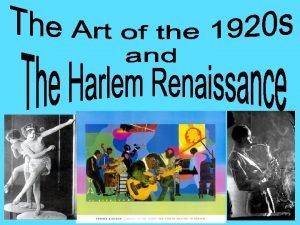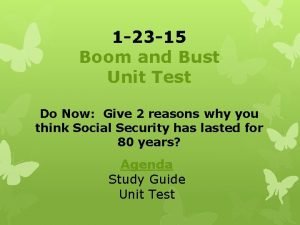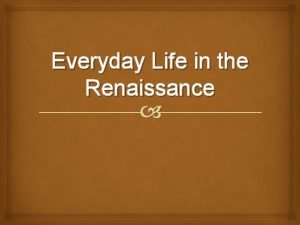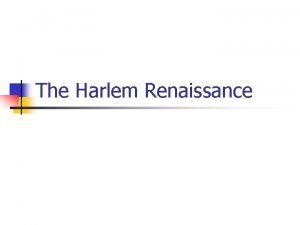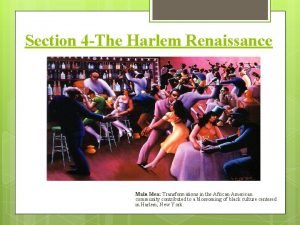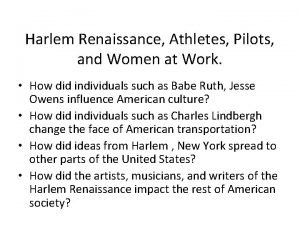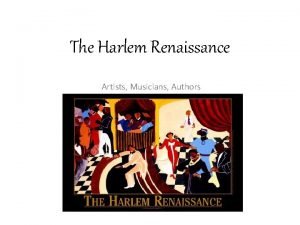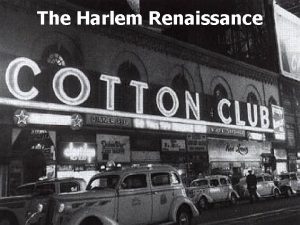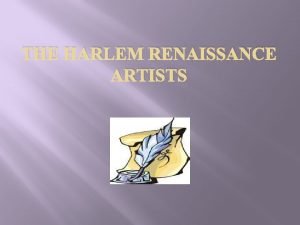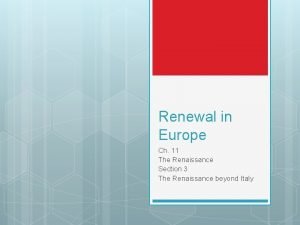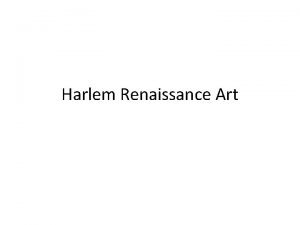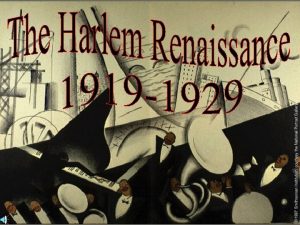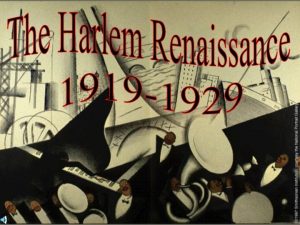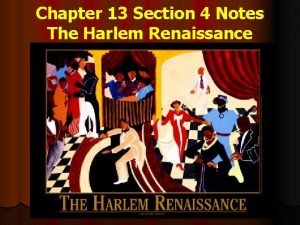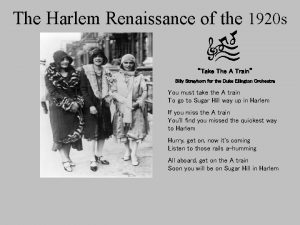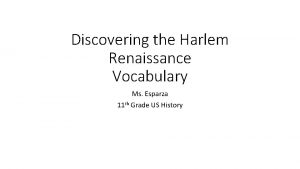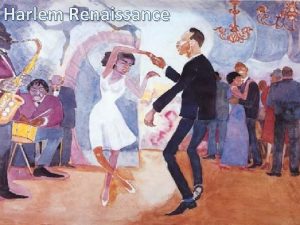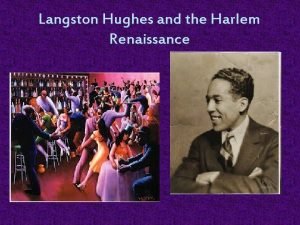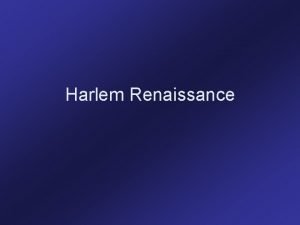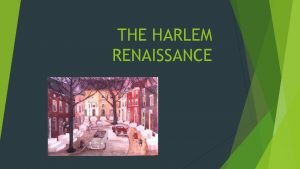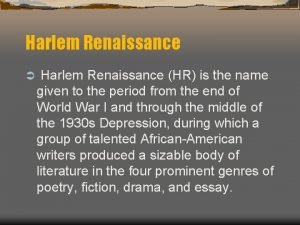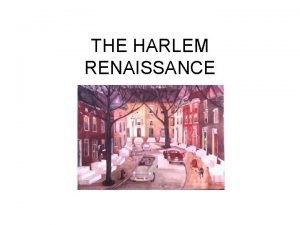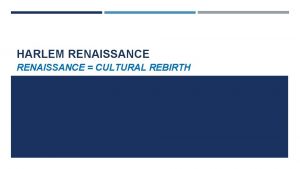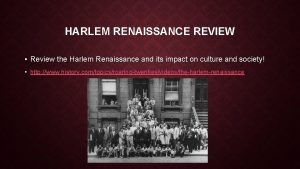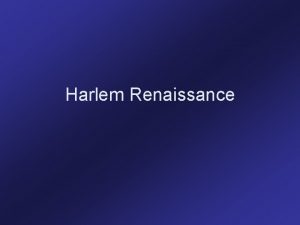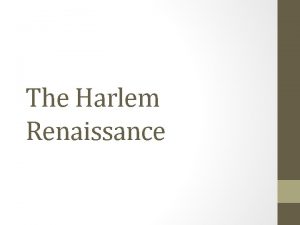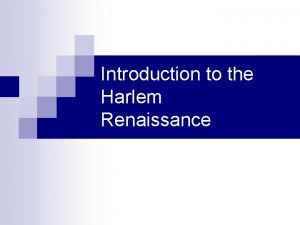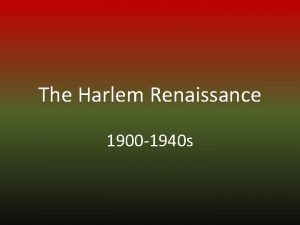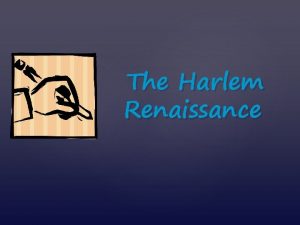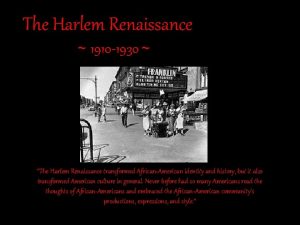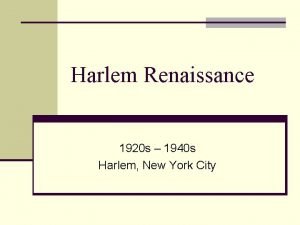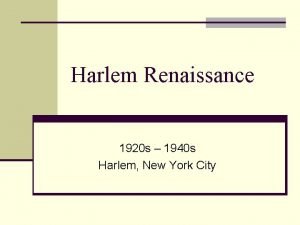Harlem Renaissance What It Was Harlem Renaissance A





















- Slides: 21

Harlem Renaissance

What It Was • Harlem Renaissance – A flowering of African American art, literature, music and culture in the United States led primarily by the African American community based in Harlem, New York City.

When It Occurred • Beginning: – 1924 Opportunity magazine hosted a party for black writers with many white publishers attending • Ending: – 1929, the year of the stock market crash and the resulting economic Great Depression.

Who? • Descendants from a generation whose parents or grandparents had witnessed slavery and Reconstruction • Lived in a country governed by Jim Crow laws.


Who? • Many of these people were part of the Great Migration out of the South and other racially stratified communities ;

Between 1910 and 1930, the African American population in the North rose by about 20 percent overall. Cities such as Chicago, Detroit, New York, and Cleveland had some of the biggest increases.

Factors behind the Great Migration • Avoid the racial segregation of Jim Crow laws in the South • Boll weevil infestation in Southern cotton in the late 1910 s forced people to search for other work • Blacks could take the service jobs that new white factory workers had vacated; • The Immigration Act of 1924 stopped European immigrants, causing a shortage of factory workers; • The Great Mississippi Flood of 1927 displaced thousands of African-American farm workers.


Effects of the Harlem Renaissance • Music • Literature • Art

Music • Jazz – Brass and woodwind instruments with trumpets, trombones and saxophones playing lead parts – Characterized by intricate leads and accidentals – Complex chords, syncopated rhythms – Improvised solos

Music • Big Band or Swing – No microphones meant that musicians increased band size to increase sound – Used composers and arrangers – Little room for improvisation

Notable Musicians


Notable Writers Langston Hughes Countee Cullen Zora Neale Hurston

Notable Artists Self Portrait with Bandana, William Johnson

Portrait Bust of Paul Robeson Sir Jacob Epstein Midonz, Ronald Moody

Les Fetiches, Lois Mailou Jones

Dust to Dust, Jacob Lawrence

Blues, Archibald Motley, Jr.

Café, William H. Johnson
 Harlem renaissance flappers
Harlem renaissance flappers The harlem renaissance: mastery test
The harlem renaissance: mastery test Daily life during the renaissance
Daily life during the renaissance Define harlem renaissance
Define harlem renaissance Harlem renaissance
Harlem renaissance The harlem renaissance main idea
The harlem renaissance main idea Harlem renaissance athletes
Harlem renaissance athletes Harlem renaissance project ideas
Harlem renaissance project ideas Harlem renaissance
Harlem renaissance Define renaissance
Define renaissance Bessie smith harlem renaissance
Bessie smith harlem renaissance Words like freedom by langston hughes
Words like freedom by langston hughes Harlem renaissance brainpop answers
Harlem renaissance brainpop answers Themes of the harlem renaissance
Themes of the harlem renaissance Map of harlem 1920s
Map of harlem 1920s Harlem renaissance themes
Harlem renaissance themes Chapter 13 section 4 the harlem renaissance answer key
Chapter 13 section 4 the harlem renaissance answer key Harlem renaissance vocabulary
Harlem renaissance vocabulary Harlem renaissance poems
Harlem renaissance poems Harlem renaissance vocabulary
Harlem renaissance vocabulary Harlem renaissance began
Harlem renaissance began Crash course harlem renaissance
Crash course harlem renaissance
